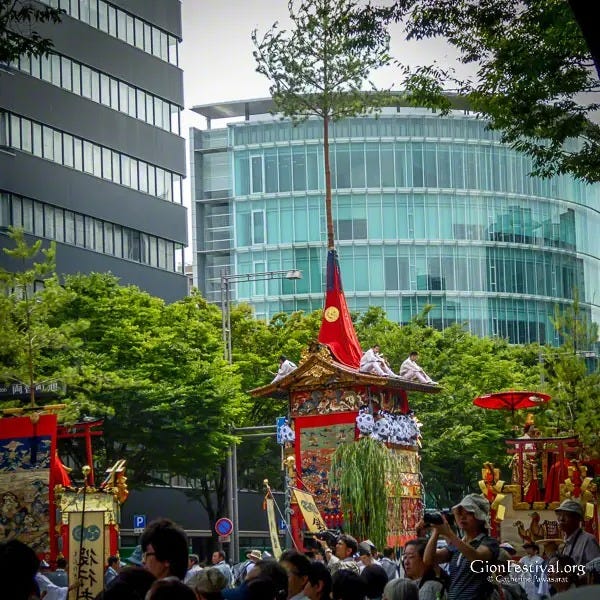Each summer, after the thunderous processions of the Saki Matsuri, Kyoto’s winding Shinmachi-dōri transforms into a stage for the intimate, neighborhood-led Ato Matsuri (July 18–24). Here, five storied floats — Koi Yama, Minami Kannon Yama, Ōfune Boko, Suzuka Yama, and Kuronushi Yama — stand as floating palaces of art, myth, and devotion.
Koi Yama (“Carp That Became a Dragon”) captures the spirit of perseverance. Its sculpted carp surges through painted waves and a cascading hemp “waterfall,” recalling the ancient Chinese legend of koi ascending to the heavens as dragons. Inside, a lavish 16th-century Brussels Gobelin tapestry depicts scenes from Homer’s Iliad, symbolizing cross-cultural currents that have flowed through Kyoto for centuries.
Minami Kannon Yama pays homage to Kannon, the bodhisattva of compassion. Atop this float, an antique wooden Kannon statue gazes serenely from its second-story treasure chamber. The surrounding panels portray the four mythic beasts — dragon, tiger, phoenix, and tortoise — invoking protection and balance, and inviting festival-goers to pause amid the revelry for a moment of quiet reflection.

Revived in 2014, Ōfune Boko (“Great Ship”) is the only hoko-style float in the Ato Matsuri. Once dormant for 125 years, it now sails again along Shinmachi-dōri, its massive prow commemorating Empress Jingū’s legendary voyage to Silla. With treasures rescued from the 1864 fire — painstakingly cataloged through Ritsumeikan University’s digital imaging — the float embodies resilience, community fundraising, and the enduring bond between past and present.
Suzuka Yama brings martial lore to life. Adorned with a noh mask, sword, and naginata, it honors Suzuka Myōjin, the warrior goddess who, legend tells, vanquished a demon along the old Tōkaidō route. The red-haired scalp at the float’s base and embroidered phoenix motifs underscore her role as protector of travelers, merchants, and all who seek safe passage.
Finally, Kuronushi Yama celebrates Ōtomo-no-Kuronushi, the Heian poet deified for his lyrical mastery. Originally known as Saigyō Yama, its modern revival draws on Gion’s rich oral traditions. Inside its treasure hall, rare Chinese silk textiles shimmer alongside live Japanese commentary, weaving historical scholarship with poetic storytelling.
Stroll Shinmachi-dōri at dawn or twilight during the Ato Matsuri, and you’ll encounter these floating shrines, each a microcosm of Kyoto’s layered heritage. From aquatic legends and Buddhist compassion to imperial odysseys and martial epics, Koi Yama, Minami Kannon Yama, Ōfune Boko, Suzuka Yama, and Kuronushi Yama together compose a living tapestry of faith, artistry, and neighborhood pride.
For an immersive guide and schedule, explore the official Ato Matsuri page:
https://www.gionfestival.org/yamaboko-floats/ato-matsuri/
Comments
Post a Comment